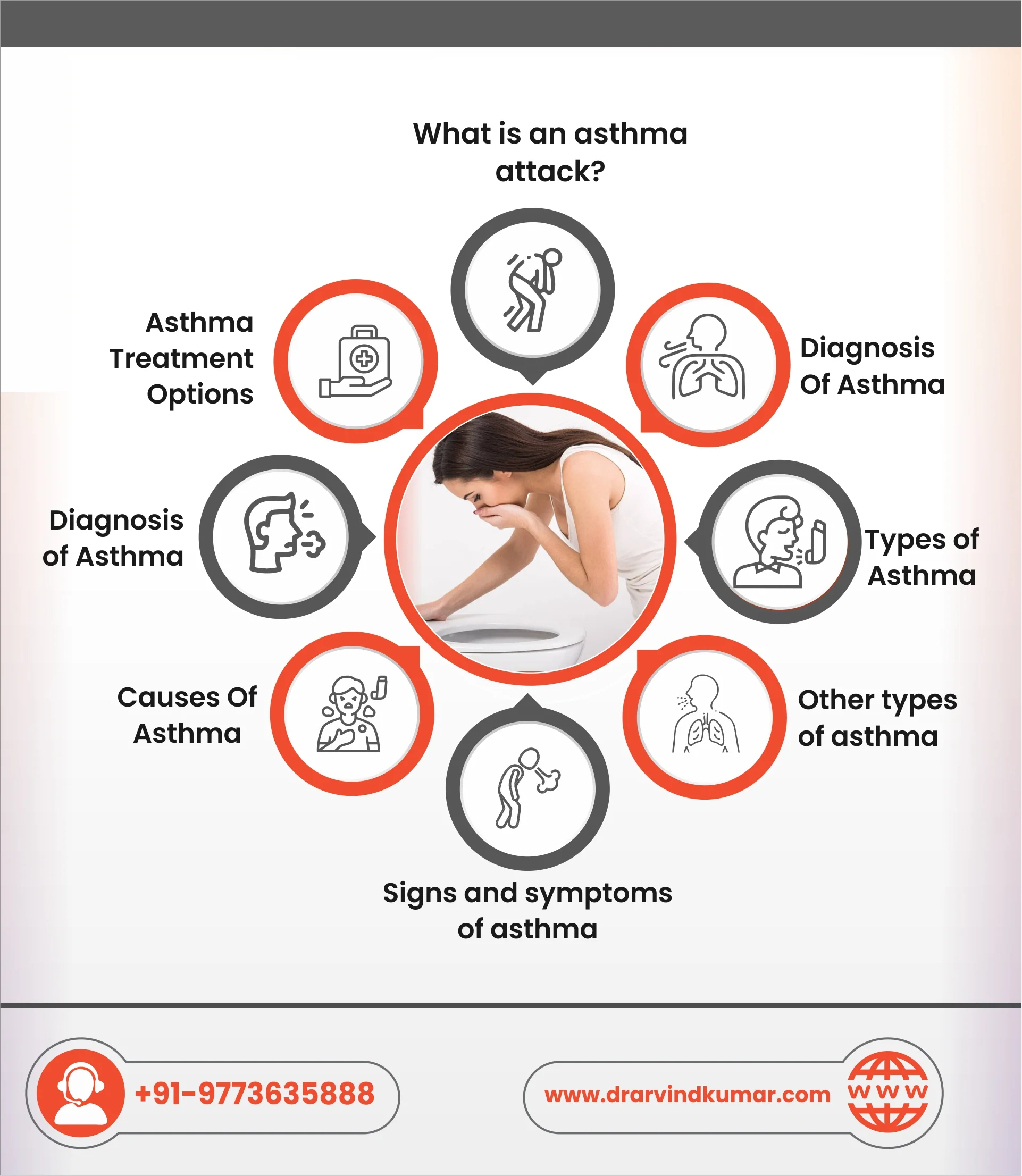Bronchial asthma, more simply known as asthma, is a type of Lung illness that causes damage to your lungs. It is a continuous, i.e., chronic condition that needs constant medical care.
Understanding a little about how breathing works is crucial to comprehend bronchial asthma. In a typical breathing pattern, air passes through your nose or mouth, descends into your throat, enters your airways, and eventually reaches your lungs.
Your lungs include a large number of tiny airways that assist in transferring oxygen from the surrounding air to your bloodstream. When the muscles surrounding your airways constrict and the lining of your airways expands, signs of asthma develop. Furthermore, as mucus fills the airways, the air that can pass through is subsequently reduced.
As a result, coughing, wheezing when you exhale, and shortness of breath are typical signs of asthma, making breathing more challenging. The coughing and chest tightness characteristic of an asthma “attack” can result from these circumstances. If left untreated, asthma could be fatal.
What is an asthma attack?
While you breathe regularly, the muscles surrounding your airways relax, allowing the air to pass through them effortlessly and silently.These outcomes are likely possible to be asthma attack symptoms:
Bronchospasm: The airways surrounding muscles tighten (tighten). The tightening of your airways makes them more congested. Constrictions of the airways block the free passage of air.
Inflammation: Your airways lining swells due to inflammation. The amount of air that may exit or enter your lungs may get restricted by inflamed air passages.
Mucus production: More mucus is produced by your body during an attack. Heavy mucus causes the airways to become blocked.
Wheezing: Wheezing is a condition that occurs when your airways become more constricted, and a sound is made by your airways whenever you exhale.
An asthma attack may also be referred to as an exacerbation or a flare-up. It is a term used to describe asthma that is not under control. Even though an exacerbation might quickly stop without medicine, you should still see your doctor because it may be life-threatening. The more your breathing is impacted by an exacerbation, the longer it lasts. Exacerbations frequently necessitate a trip to the emergency department because of this. Taking drugs to treat your asthma symptoms can help you avoid exacerbations.
Diagnosis Of Asthma
The following can assist with asthma diagnosis:
Health background- Your risk is increased if you have relatives who suffer from a breathing disorder. Discuss your genetic connection with your doctor.
Physical examination- Your doctor will use a stethoscope to check your breathing. A skin test may also be performed to check for any indications of an allergic reaction, such as eczema, hives, etc. Allergies increase asthma risk.
Respiratory tests- The flow of air into and out of your lungs is checked by pulmonary function tests (PFTs). You blow into a device that gauges air velocity for the most common test, spirometry.
Types of Asthma
Your doctor will need to determine the kind of asthma you have. An estimated 60% of all instances of asthma are of the common kind, allergic asthma. A persons stage in life can affect additional types of asthma. Although asthma can develop at any age, adult-onset asthma doesn start until later in life and only affects children.
Depending on how severe it was prior to therapy, the illness is categorized by the National Asthma Education and Prevention Program (NAEPP). Classifications for asthma include
Intermittent. This sort of asthma, which doesn interfere with daily activities, is common. Mild symptoms only last a couple of days or nights each week or month.
Mild persistence- The symptoms manifest more than twice a week, but not every day, and up to four nights every month.
Moderate persistence The symptoms don happen every night; they happen every day and at least once a week. Some daily activities might be restricted.
Severely persistent Most evenings and multiple times a day, the symptoms appear. There is a severe lack of daily activity.
Additional specific types of asthma include
Allergic Asthma: In certain cases, asthma attacks are brought on by allergens. Airborne chemicals and allergens, such as mold, dust, pollen, food, and pet dander, cause it. Due to its close association with seasonal allergens, allergic asthma is frequently seasonal.
Non-allergic Asthma: This form of asthma is brought on by airborne irritants unrelated to allergies. A flare-up of asthma can be brought on by external irritants such as smoking, wood burning, cold air, air pollution, viral diseases, air fresheners, household cleaning supplies, exercise, stress, illness, and weather, as well as perfumes, may bring on a flare.
Other types of asthma
Adult-onset: After the age of 18, this form of asthma develops.
Pediatric: Also known as pediatric asthma, this disease can affect newborns and toddlers and frequently develops before the age of 5. Asthma may be outgrown in kids. Before you determine if your child needs to keep an inhaler on hand in case they experience an asthma attack, make sure you talk to your doctor about it. Your child’s pediatrician can assist you in understanding the associated risks.
Further classification of asthma types:
Exercise-induced asthma- A form of asthma resulting from physical activity is called exercise-induced bronchospasm. Exercise-induced bronchoconstriction (EIB) attack is usually brought on a few minutes after exercising and may last up to 10 to 15 minutes afterward. Earlier, this condition was known as exercise-induced asthma (EIA). Of people with an asthma condition, almost 90% of people may experience EIB, but all people with EIB may not necessarily have other kinds of asthma.
Occupational asthma: Those who spend a lot of time around irritants at work may develop occupational asthma. Common irritants include industrial chemicals, rubber latex, dust, gases and fumes, dyes, and animal proteins.
Asthma-COPD overlap syndrome (ACOS): When you have both asthma and chronic obstructive pulmonary disease, you have what is known as the asthma-COPD overlap syndrome (ACOS) (COPD). Breathing becomes challenging in both conditions.
Causes Of Asthma
Why some people develop asthma and others do not is a question still unanswered by researchers. However, some elements increase the risk:
Allergies: People are more likely to develop asthma if they are prone to allergies.
Environmental factors: People whose airways get irritated from exposure to allergens are likely to develop asthma. Some examples are allergens, gasses, poisonous substances, and second- or third-hand smoke. These may be specifically dangerous for those persons whose immune systems are still maturing such as babies and young children.
Genetics: If anyone in your family has asthma, or your family has a history of an allergy disease or its conditions, then you are at a greater risk of acquiring asthma
Respiratory infections: Some respiratory diseases, such as the respiratory syncytial virus (RSV), can harm young childrens still-developing lungs.

Signs and symptoms of asthma
People who have asthma typically exhibit clear symptoms. Many respiratory illnesses have symptoms and indications similar to these ones:
- Chest pressure, discomfort, or clenching
- Coughing (particularly at night)
- breathing difficulty
- Wheezing
It is not necessary that you will experience all these symptoms with every asthma attack. Your asthma symptoms and indicators may alter over time when you have Chronic asthma. The symptoms of asthma might also alter between attacks.
Symptoms of an asthma attack include:
- More persistent and annoying asthma signs and symptoms
- Increasingly more difficult and challenging breathing as indicated by a lung function tester (peak flow meter)
- Using quick-relief inhalers more frequently
Diagnosis of Asthma
To diagnose asthma, your doctor conducts your medical background check, including details about your parents and siblings. Your doctor will also ask questions related to your symptoms. If you have a history of allergies, skin conditions such as eczema (an itchy rash brought on by allergies), or other lung conditions, then these should be disclosed to your doctor. Your doctor may prescribe a chest X-ray, a blood test, and a skin test.
Physical examination – To rule out further illnesses, such as a respiratory infection or chronic obstructive pulmonary disease, your doctor will do a physical examination (COPD). Your doctor will also inquire about your signs and symptoms and any further health issues.
Lung function tests – may be performed on you to assess how much air enters and leaves your lungs during each breath. These tests may include
- Spirometry- This test is used for diagnosing and tracking your recovery and gauging how well your lungs are working. This test calculates the constriction of your bronchial tubes by measuring how much air you can exhale after taking a deep breath and how quickly you can breathe out.
- Peak flow- A simple tool called a peak flow meter assesses how forcefully you can exhale. Peak flow measurements that are lower than normal indicate that your lungs may not be functioning as well and that your asthma may be becoming worse. Youll receive guidance from your doctor on how to monitor and manage low peak flow values.
Before and after using a bronchodilator, using a medicine to open your airways, such as albuterol, lung function tests are frequently conducted. You probably have asthma if using a bronchodilator causes your lung function to improve.
Asthma Treatment Options
To control symptoms, your doctor may recommend drugs as a part of asthma treatment. These consist of:
Bronchodilators – Bronchodilators are drugs that ease the muscles surrounding your airways. This enables the airways to become relaxed, enabling movement as the muscles are loosened. This also allows the mucus to pass easily through the airways. These medications are used for providing temporary symptom relief as well as for treating both chronic asthma and intermittent asthma.
Anti-inflammatory drugs – These drugs reduce the inflammation of the airways and also lessen mucus production. They allow the air to move freely into and out of your lungs. Your doctor may recommend daily use of these drugs to manage or avoid your persistent asthma symptoms.
Biologic therapies – When symptoms of severe asthma persist after adequate inhaler medication, biologic medicines are employed.
Asthma medications can be administered and taken in several ways. You can breathe in the medications using nebulizers, metered-dose inhalers, or another type of asthma inhaler or asthma pump. Your doctor can also give you medications to swallow orally.
Asthma Complications
Complications of asthma include:
- Symptoms that interfere with sleep, working, or doing other things
- Absences from work or school due to asthma attacks
- A condition where your bronchial tubes, which carry air to and from your lungs, permanently shorten, impairing your ability to breathe
- Severe asthma attacks that require hospitalization and emergency room visits
- Effects of several drugs used to stabilize severe asthma after long-term use
Effective asthma management can significantly reduce the risk of both immediate and long-term consequences.
Asthma action plan
To build an action plan for your asthma, consult your doctor. Based on your symptoms, this plan explains when and how to take specific prescriptions, when to raise or reduce the dose of your medications, where to store your asthma pump or asthma inhalers in case of emergency, etc. List your triggers and the steps you must take to avoid them.
To check how well your medication regulates your asthma, your doctor may advise keeping track of your symptoms or regularly using a peak flow meter. Your asthma action plan will also specify when to seek emergency medical attention based on your asthma symptoms. Consult with your doctor if there is anything that you don understand.
Conclusion
Having asthma can be difficult and stressful. You could occasionally experience feelings of frustration, rage, or depression due to having to reduce your typical activities to avoid environmental triggers. Additionally, you can feel constrained or ashamed by the diseases symptoms and challenging management procedures.
However, asthma need not be a debilitating illness. Understanding your disease and taking charge of your therapy is the best way to eliminate worry and a sense of helplessness. Many people with asthma lead happy lives. Some asthmatic professional athletes have achieved sporting records. The ideal asthma management strategy might be discovered with the aid of your healthcare specialist. How to manage your symptoms should be discussed with your healthcare professional.
Frequently Asked Questions
What should I know about asthma and COVID-19?
You run a higher risk of needing hospitalisation if you have moderate-to-severe asthma or uncontrolled asthma symptoms if you receive COVID-19. As a result, you should get vaccinated, wear a mask while entering enclosed spaces with others, and stay away from infected individuals.
How do I stop asthma attacks?
Although you cannot stop yourself from developing asthma however the illness is fairly manageable if you develop it. The causes of asthma attacks must be identified if you get an asthma diagnosis. By avoiding triggers that may cause you to have an asthma attack, you may be able to prevent it.

.webp)



